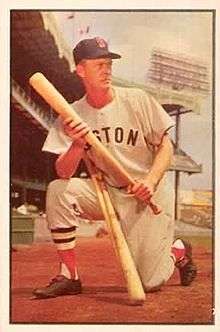Hoot Evers
| Hoot Evers | |||
|---|---|---|---|
 | |||
| Center fielder / Left fielder | |||
|
Born: February 8, 1921 St. Louis, Missouri | |||
|
Died: January 25, 1991 (aged 69) Houston, Texas | |||
| |||
| MLB debut | |||
| September 16, 1941, for the Detroit Tigers | |||
| Last MLB appearance | |||
| September 30, 1956, for the Baltimore Orioles | |||
| MLB statistics | |||
| Batting average | .278 | ||
| Home runs | 98 | ||
| Runs batted in | 565 | ||
| Teams | |||
| Career highlights and awards | |||
Walter Arthur "Hoot" Evers (February 8, 1921 – January 25, 1991) was an outfielder in Major League Baseball who played twelve seasons in the major leagues with the Detroit Tigers (1941, 1946–1952, 1954), Boston Red Sox (1952–1954), New York Giants (1954), Baltimore Orioles (1954, 1956), and Cleveland Indians (1955–1956).
Early years
Born in St. Louis, Missouri in 1921, Evers gained the nickname "Hoot" as a child when he was a devoted fan of the films of Richard "Hoot" Gibson, a popular cowboy who released nearly 75 short films during the first 10 years of Evers’ life.
Evers graduated from Collinsville High School in Collinsville, Illinois, then attended the University of Illinois at Urbana–Champaign where he was a star baseball and basketball player. He is still among the school's all-time leaders in triples. Evers was signed by the Detroit Tigers as an amateur free agent in 1941 and was considered one of the brightest prospects in baseball. After playing one major league game on September 16, 1941, Evers' baseball career was put on hold while he served four years in the military during World War II.
Evers returned to the Tigers in 1946, playing 76 games in center field, but missing half the season with a broken ankle.
Peak years with Detroit (1947–1950)
In 1947, the 26-year-old Evers finally played his first full season in the big leagues. He had a .296 batting average and a .344 on-base percentage. He was selected for the American League All-Star team in 1948 and 1950.
Evers' career peaked in the three years from 1948 to 1950, hitting over .300 all three years and batting in over 100 runs in 1948 and 1950.
Evers' best season was 1950 when he led the American League in triples (11) and was among the American League leaders in most batting categories. That year, he had a .551 slugging percentage (3rd in the AL behind Joe DiMaggio), 34 doubles (4th in the AL), .959 OPS (4th in the AL), 67 extra base hits (6th in the AL), .323 batting average (7th in the AL), 109 RBIs (9th in the AL), 259 total bases (9th in the AL), and .408 on-base percentage (10th in the AL). Evers hit for the cycle on September 7, 1950, in a 13–13 tie against the Cleveland Indians. As of May 2014, he remains the only major league player to hit two triples and hit for the cycle in the same game.[1]
Evers was also a solid fielder, leading all American League outfielders in fielding percentage (.997) in 1950 with one error in over 325 chances. With strong performances in the field and at the bat, Evers finished No. 11 in the 1950 American League MVP voting.
When Evers came to the plate in Detroit, Tigers fans would rise to their feet and yell "Ho-o-o-o-t", "Ho-o-o-o-t." A story in the 1951 edition of "Who's Who" said the following about Evers: "The blond that Detroit fans prefer, fielded .997 last season, hit .323 – to raise his popularity rating even higher. Come on Ho-o-o-o-t!"
Later years

In 1951 Evers's bat went cold as his batting average dropped nearly 100 points from .323 to .224, and his RBI production dropped from 103 to 46.
After playing only one game for the Tigers in 1952, Evers was part of a blockbuster trade on June 3, 1952 that sent George Kell, Johnny Lipon, Dizzy Trout, and Evers to the Boston Red Sox.
With Ted Williams serving in the military, Evers became the Red Sox starting left fielder in 1952, and he hit .262 with 59 RBIs. A broken finger in 1952 reportedly hampered Evers' grip, and he never regained his stroke. Evers played four more major league seasons from 1953 to 1956, but he did not hit above .251 or collect more than 39 RBIs.
In 1,142 career games, Evers batted .278 with 98 home runs, 565 RBIs, and 1,055 hits.
Baseball management
After his playing career ended, he worked in the Cleveland Indians organization for several years and was a member of the team's coaching staff in 1970. In 1971, he joined the Detroit Tigers as director of player development. In 1978, he became a special assignment scout for the Tigers in Houston.
Tigers' manager Jim Leyland praised Evers in 2005: "Hoot Evers was probably the number-one motivational guy for me. He was a farm director for the Detroit Tigers. Hoot Evers, Bill Lajoie and Ed Katalinas advised me to begin a career in the minor league system. ... If I had to look back and pick one person that really motivated me and really let me know what it's about, it would be Hoot Evers." ("October Baseball", by Dan Zachofsky (2005), p. 35)
Evers died in Houston, Texas in 1991. He was 69 years old and had recently suffered a heart attack.
See also
References
- ↑ "Batting Game Finder: From 1914 to 2014, (requiring 1B>=1, 2B>=1, 3B>=2 and HR>=1), sorted by name". Baseball-Reference.com. Retrieved May 2, 2014. Includes data from 1914 onwards.
External links
- Career statistics and player information from Baseball-Reference
- BR Bullpen
- New York Times Obituary
- BaseballLibrary.com
- Hardball Times Article on Hoot Evers